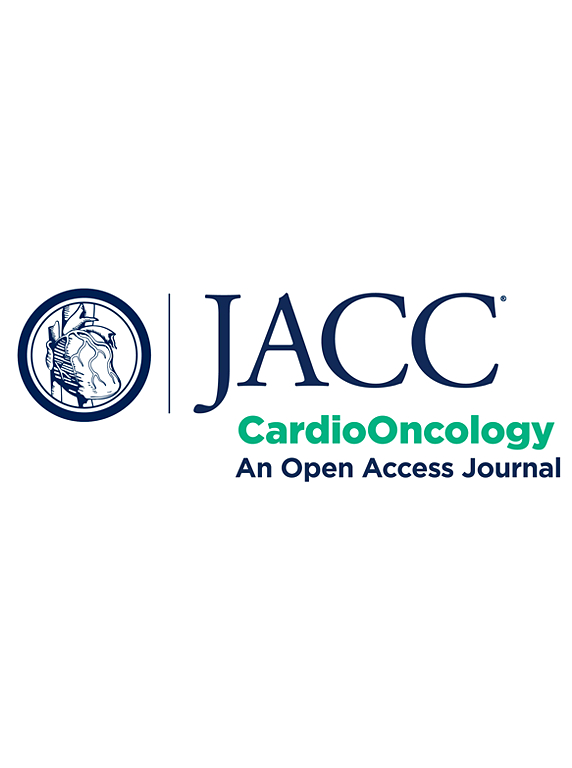Immune Checkpoint Inhibitor–Related Myocarditis With or Without Concomitant Myopathy
IF 12.8
1区 医学
Q1 CARDIAC & CARDIOVASCULAR SYSTEMS
引用次数: 0
Abstract
Background
Data on cardiovascular outcomes in patients with both immune checkpoint inhibitor–induced immune-related myocarditis (irMyocarditis) and immune-related myopathy (irMyopathy) are limited.
Objectives
The aim of this study was to describe clinical characteristics and cardiovascular outcomes in patients with isolated irMyocarditis vs those with concomitant irMyocarditis and irMyopathy.
Methods
A retrospective cohort study was conducted among patients diagnosed with irMyocarditis at Massachusetts General Brigham between 2015 and 2023. Clinical, laboratory, and imaging characteristics were evaluated, and cardiovascular outcomes were compared between patients with and those without concomitant irMyopathy. The outcomes assessed included acute heart failure requiring diuresis, significant arrhythmias (ventricular arrhythmias and high-degree atrioventricular block), and cardiovascular and all-cause mortality during the index hospitalization.
Results
Among 101 patients with irMyocarditis, 32 (31.7%) had concomitant irMyopathy. Patients with irMyocarditis and irMyopathy had higher high-sensitivity troponin T (median 716 ng/L vs 75 ng/L; P < 0.001) and creatine kinase levels (median 3441 U/L vs 232 U/L; P < 0.001) and were more likely to present with significant arrhythmias (HR: 2.12; 95% CI: 1.13-3.97; P = 0.019). Conversely, patients with isolated irMyocarditis had higher N-terminal prohormone of brain natriuretic peptide levels (median 2043 pg/mL vs 606 pg/mL; P = 0.007), lower left ventricular ejection fractions (median 56% vs 65%; P = 0.008), and a higher likelihood of acute decompensated heart failure (HR: 5.88; 95% CI: 1.45-25; P = 0.013). Cardiovascular and all-cause death during admission were numerically higher in patients with concomitant irMyopathy but were not significantly different between the 2 groups.
Conclusions
Patients with irMyocarditis and irMyopathy and those with isolated irMyocarditis have distinct biomarker profiles and cardiovascular complications. These differences should be confirmed in larger prospective cohorts to guide tailored management strategies.
免疫检查点抑制剂相关心肌炎伴或不伴肌病
背景有关免疫检查点抑制剂诱导的免疫相关性心肌炎(irMyocarditis)和免疫相关性肌病(irMyopathy)患者心血管预后的数据十分有限。本研究旨在描述孤立的虹膜心肌炎患者与同时患有虹膜心肌炎和虹膜肌病的患者的临床特征和心血管预后。方法对2015年至2023年期间在马萨诸塞州总布里格姆医院确诊的虹膜心肌炎患者进行了一项回顾性队列研究。研究评估了临床、实验室和影像学特征,并比较了合并和未合并虹膜心肌病的患者的心血管预后。评估的结果包括需要利尿的急性心力衰竭、严重心律失常(室性心律失常和高度房室传导阻滞)以及指数住院期间的心血管和全因死亡率。虹膜心肌炎和虹膜心肌病患者的高敏肌钙蛋白 T(中位数为 716 ng/L vs 75 ng/L;P <;0.001)和肌酸激酶水平(中位数为 3441 U/L vs 232 U/L;P <;0.001)较高,更容易出现明显的心律失常(HR:2.12;95% CI:1.13-3.97;P = 0.019)。相反,孤立性虹膜心肌炎患者的脑钠肽 N 端前体水平较高(中位数为 2043 pg/mL vs 606 pg/mL;P = 0.007),左室射血分数较低(中位数为 56% vs 65%;P = 0.008),出现急性失代偿性心力衰竭的可能性较高(HR:5.88;95% CI:1.45-25;P = 0.013)。结论患有虹膜心肌炎和虹膜心肌病的患者与单独患有虹膜心肌炎的患者具有不同的生物标志物特征和心血管并发症。这些差异应在更大规模的前瞻性队列中得到证实,以指导量身定制的管理策略。
本文章由计算机程序翻译,如有差异,请以英文原文为准。
求助全文
约1分钟内获得全文
求助全文
来源期刊

Jacc: Cardiooncology
Multiple-
CiteScore
12.50
自引率
6.30%
发文量
106
期刊介绍:
JACC: CardioOncology is a specialized journal that belongs to the esteemed Journal of the American College of Cardiology (JACC) family. Its purpose is to enhance cardiovascular care for cancer patients by publishing high-quality, innovative scientific research and sharing evidence-based knowledge.
The journal aims to revolutionize the field of cardio-oncology and actively involve and educate professionals in both cardiovascular and oncology fields. It covers a wide range of topics including pre-clinical, translational, and clinical research, as well as best practices in cardio-oncology. Key areas of focus include understanding disease mechanisms, utilizing in vitro and in vivo models, exploring novel and traditional therapeutics (across Phase I-IV trials), studying epidemiology, employing precision medicine, and investigating primary and secondary prevention.
Amyloidosis, cardiovascular risk factors, heart failure, and vascular disease are some examples of the disease states that are of particular interest to the journal. However, it welcomes research on other relevant conditions as well.
 求助内容:
求助内容: 应助结果提醒方式:
应助结果提醒方式:


